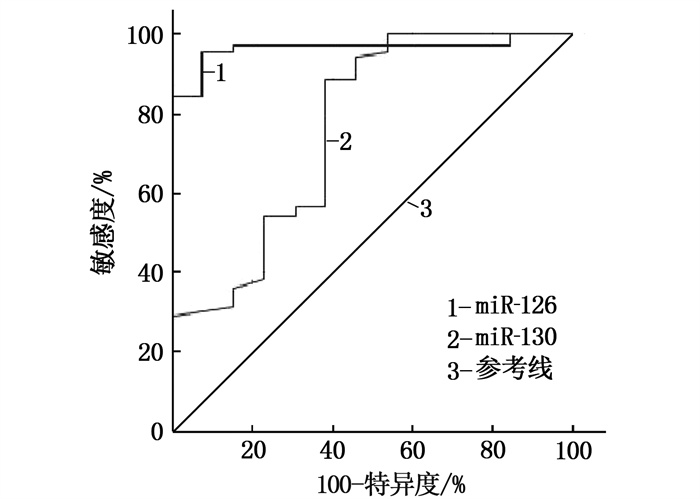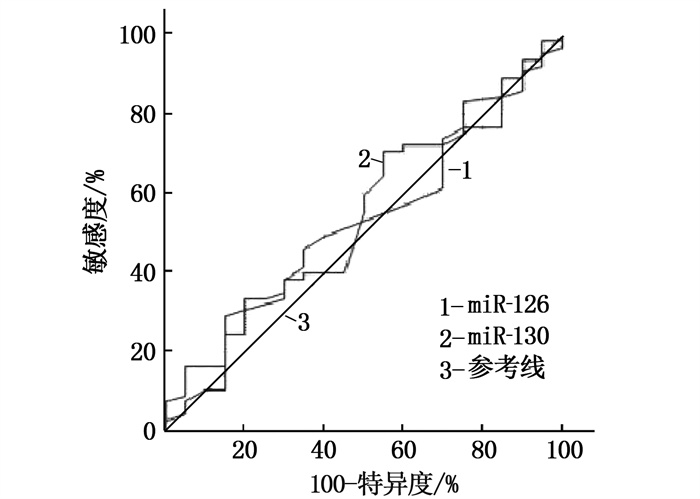Value of plasma microRNA-126 and microRNA-130 in evaluating prognosis of acute myocardial infarction after emergency percutaneous coronary intervention
-
摘要:目的
探讨血浆微小RNA(miR)-126与miR-130对急性心肌梗死急诊经皮冠状动脉介入治疗(PCI)的预后评估价值。
方法选取170例急性心肌梗死患者为病例组,同期60例健康体检人员为对照组,比较病例组与对照组血浆miR-126与miR-130的含量。患者术后随访12个月,根据术后30 d以及术后12个月主要不良心血管事件(MACE)发生情况,将患者分为近期预后不良组(n=26, 术后30 d发生MACE)与近期预后良好组(n=144, 术后30 d未发生MACE)、远期预后不良组(n=40, 术后12个月发生MACE)与远期预后良好组(n=130, 术后12个月未发生MACE)。比较近期不同预后组左室射血分数(LVEF)、N端脑钠肽前体(NT-ProBNP)、肌钙蛋白T(cTnT)表达水平差异。比较近期不同预后组和远期不同预后组的miR-126与miR-130相对表达水平的差异。采用Pearson相关法分析指标的相关性; 受试者工作特征曲线分析miR-126与miR-130相对表达水平对近期、远期预后结局的预测效能。
结果病例组血浆miR-126相对表达水平低于对照组, miR-130相对表达水平高于对照组,差异有统计学意义(P < 0.05)。近期预后不良组LVEF低于近期预后良好组, NT-ProBNP、cTnT表达水平高于近期预后良好组,差异有统计学意义(P < 0.05)。近期预后不良组患者血浆miR-126相对表达水平低于近期预后良好组,而miR-130的相对表达水平高于近期预后良好组,差异有统计学意义(P < 0.05)。远期预后不良组患者血浆miR-126相对表达水平低于远期预后良好组,而miR-130的相对表达水平高于远期预后良好组,差异有统计学意义(P < 0.05)。Pearson相关法分析显示, miR-126相对表达水平与LVEF呈正相关,与NT-ProBNP、cTnT呈负相关(P < 0.05); miR-130的相对表达水平与LVEF呈负相关,与NT-ProBNP、cTnT呈正相关(P < 0.05)。血浆miR-126与miR-130的相对表达水平对患者近期预后有一定诊断效能(P < 0.05), 但评估患者术后12个月MACE预后的敏感度、特异度较低(P>0.05)。
结论血浆miR-126与miR-130可作为早期诊断急性心肌梗死的有效指标因子,但无法作为患者远期预后评估的生物学标志物。
Abstract:ObjectiveTo investigate the value of plasma microRNA(miR)-126 and miR-130 in predicting the prognosis of acute myocardial infarction after emergency percutaneous coronary intervention(PCI).
MethodsA total of 170 patients with acute myocardial infarction treated in our hospital were selected as case group. At the same time, 60 healthy people were included in control group. The contents of plasma miR-126 and miR-130 were compared between the case group and the control group. After follow-up for 12 months, the patients were divided into short-term poor prognosis group[n=26, major adverse cardiovascular events (MACE) in post-operation 30 d] and short-term good prognosis group [n=144, non-MACE in post-operation 30 d], long-term poor prognosis group[n=40, MACE in post-operation 12 months] and long-term good prognosis group [n=130, non-MACE in post-operation 12 months]according to the occurrences of MACE. The expression levels of left ventricular ejection fraction (LVEF), N-terminal brain natriuretic peptide (NT-ProBNP) and cardiac troponin T (cTnT) were compared between different prognostic groups. The relative expression levels of miR-126 and miR-130 were compared in the short-term prognostic groups and long-term prognostic groups. Pearson correlation method was used to analyze the correlations of related indexes. Receiver operating characteristic curve was used to analyze the predictive efficacy of relative expression levelsof miR-126 and miR-130 on short-term and long-term prognostic outcomes.
ResultsThe relative expression level of plasma miR-126 in the case group was lower than control group, but the relative expression level of miR-130 in the case group was higher than the control group (P < 0.05). The LVEF in short-term poor prognosis group was lower than that of the short-term good prognosis group, and the expression levels of NT-ProBNP and cTnT in the short-term poor prognosis group were higher than that in the short-term good prognosis group (P < 0.05). The relative expression level of miR-126 in the short term poor prognosis group was lower than that in the short term good prognosis group, while the relative expression level of miR-130 in the short-term poor prognosis group was higher than that in the short-term good prognosis group, and the differences were statistically significant (P < 0.05). The relative expression level of miR-126 in the long term poor prognosis group was lower than that in the long term good prognosis group, while the relative expression level of miR-130 in the long-term poor prognosis group was higher than that in the long-term good prognosis group (P < 0.05). Pearson correlation analysis showed that the relative expression level of miR-126 was positively correlated with LVEF, and negatively correlated with NT-ProBNP and cTnT(P < 0.05). The relative expression level of miR-130 was negatively correlated with LVEF, and positively correlated with NT-ProBNP and cTnT(P < 0.05). The relative expression levels of plasma miR-126 and miR-130 had certain diagnostic efficacy for the short-term prognosis of patients (P < 0.05), but they had low sensitivity and specificity in evaluating the prognosis of patients with MACE 12 months after surgery (P>0.05).
ConclusionPlasma miR-126 and miR-130 have certain significance in evaluating the short-term prognosis after emergency PCI for acute myocardial infarction, and can be used as effective factors for early diagnosis of acute myocardial infarction.
-
-
表 1 病例组与对照组相关实验室指标水平比较(x±s)
组别 miR-126 miR-130 病例组(n=170) 1.89±0.21* 1.78±0.18* 对照组(n=60) 3.23±0.35 1.12±0.10 与对照组比较, *P < 0.05。 表 2 不同组别LVEF、NT-ProBNP、cTnT表达水平比较(x±s)
组别 左室射血分数/% N端脑钠肽前体/(pg/mL) 肌钙蛋白T/(ng/mL) 近期预后不良组(n=26) 51.20±5.48*# 985.71±124.73*# 1.43±0.18*# 近期预后良好组(n=144) 56.35±5.51* 598.86±92.11* 1.08±0.12* 对照组(n=60) 73.51±4.27 91.16±28.38 0.18±0.06 与对照组比较, *P < 0.05; 与近期预后良好组比较, #P < 0.05。 表 3 不同组别血浆miR-126与miR-130的相对表达水平比较(x±s)
组别 miR-126 miR-130 近期预后不良组(n=26) 1.41±0.10*# 1.90±0.27*# 近期预后良好组(n=144) 1.80±0.21* 1.63±0.15* 对照组(n=60) 3.18±0.39 1.16±0.13 与对照组比较, *P < 0.05; 与近期预后良好组比较, #P < 0.05。 表 4 远期不同预后患者和对照组血浆miR-126和miR-130的相对表达水平比较(x±s)
组别 miR-126 miR-130 远期预后不良组(n=40) 1.50±0.12* 1.68±0.16* 远期预后良好组(n=130) 1.52±0.13* 1.70±0.18* 对照组(n=60) 3.20±0.35 1.12±0.14 与对照组比较, *P < 0.05。 -
[1] ZEYMER U, BUENO H, GRANGER C B, et al. Acute Cardiovascular Care Association position statement for the diagnosis and treatment of patients with acute myocardial infarction complicated by cardiogenic shock: A document of the Acute Cardiovascular Care Association of the European Society of Cardiology[J]. Eur Heart J Acute Cardiovasc Care, 2020, 9(2): 183-197. doi: 10.1177/2048872619894254
[2] NOWAK R M, CHRISTENSON R H, JACOBSEN G, et al. Performance of Novel High-Sensitivity Cardiac Troponin I Assays for 0/1-Hour and 0/2-to 3-Hour Evaluations for Acute Myocardial Infarction: Results From the HIGH-US Study[J]. Ann Emerg Med, 2020, 76(1): 1-13. doi: 10.1016/j.annemergmed.2019.12.008
[3] 袁健瑛, 程毅松, 贾禹, 等. 基于炎症的格拉斯哥预后评分对急性ST段抬高型心肌梗死患者预后的预测价值分析[J]. 中国胸心血管外科临床杂志, 2020, 27(1): 14-19. https://www.cnki.com.cn/Article/CJFDTOTAL-ZXYX202001003.htm [4] 李慧, 吕哲, 俞传青. MiRNA-155与沙库巴曲缬沙坦治疗心肌梗死后射血分数降低心力衰竭患者疗效的关系[J]. 中国现代医学杂志, 2021, 31(10): 70-73. doi: 10.3969/j.issn.1005-8982.2021.10.014 [5] SUN Q, SONG Y J, PRASANTH K V, et al. One locus with two roles: miRNA-independent functions of miRNA-host-gene locus-encoded long noncoding RNAs[J]. Wiley Interdiscip Rev RNA, 2021, 12(3): 1625.
[6] 周涵, 邓文文, 王冬梅, 等. 骨髓间充质干细胞源外泌体对大鼠颈动脉球囊损伤后circRNA和miRNA差异表达的影响[J]. 医学研究生学报, 2021, 34(4): 341-349. https://www.cnki.com.cn/Article/CJFDTOTAL-JLYB202104002.htm [7] 中华医学会心血管病学分会, 中华心血管病杂志编辑委员会, 《中国循环杂志》编辑委员会. 急性心肌梗死诊断和治疗指南[J]. 中华心血管病杂志, 2001, 29(12): 710-725. doi: 10.3760/j:issn:0253-3758.2001.12.003 [8] MUZYK P, TWERENBOLD R, MORAWIEC B, et al. Use of cardiac troponin in the early diagnosis of acute myocardial infarction[J]. Kardiol Pol, 2020, 78(11): 1099-1106. doi: 10.33963/KP.15585
[9] 卢翠莲. 麝香保心丸联合瑞舒伐他汀治疗对老年冠心病患者血脂、血管内皮功能及外周血miR-126和miRNA-137表达的影响[J]. 中国动脉硬化杂志, 2020, 28(2): 158-162. doi: 10.3969/j.issn.1007-3949.2020.02.013 [10] 李童, 李学文, 米小龙. 缺血后适应通过上调miRNA-21和miRNA-126发挥心脏保护效应[J]. 中国心血管病研究, 2020, 18(4): 354-358. doi: 10.3969/j.issn.1672-5301.2020.04.015 [11] TAO J, XIA L, CAI Z, et al. Interaction Between miRNA and DNA Methylation in Atherosclerosis[J]. DNA Cell Biol, 2021, 40(1): 101-115. doi: 10.1089/dna.2020.6138
[12] 周红, 娜日罕, 荣钰, 等. 扩张型心肌病患者两种治疗方法前后miR-126和miRNA-30a水平表达的研究[J]. 现代检验医学杂志, 2020, 35(4): 6-9. doi: 10.3969/j.issn.1671-7414.2020.04.002 [13] 浩日瓦, 娜日罕, 周红, 等. 血清miRNA126和miRNA1检测对心衰诊断价值的研究[J]. 现代检验医学杂志, 2018, 33(3): 18-20, 23. doi: 10.3969/j.issn.1671-7414.2018.03.006 [14] 张海涛, 林文勇, 解曼曼, 等. 冠心病患者外周血外泌体中miRNA基因芯片的差异性表达[J]. 临床心血管病杂志, 2019, 35(6): 501-505. https://www.cnki.com.cn/Article/CJFDTOTAL-LCXB201906004.htm [15] 石清, 李俊, 田季雨, 等. miRNA-126在冠心病患者中的表达及与Gensini评分、BNP、cTnI、LDL的相关性研究[J]. 现代中西医结合杂志, 2019, 28(10): 1085-1088. doi: 10.3969/j.issn.1008-8849.2019.10.014 [16] 徐小燕, 宋子凯, 张洋, 等. 急性心肌梗死急诊行PCI术后患者血清氨基末端脑钠肽前体和脂蛋白a水平变化及其临床意义[J]. 吉林大学学报: 医学版, 2020, 46(1): 132-137. https://www.cnki.com.cn/Article/CJFDTOTAL-BQEB202001025.htm [17] 胡美荣, 张嵚垚, 杨智勇. γ-谷氨酰转移酶对急性心肌梗死患者PCI术后无复流及预后的预测价值[J]. 中国医科大学学报, 2021, 50(8): 723-727. https://www.cnki.com.cn/Article/CJFDTOTAL-ZGYK202108011.htm [18] 李建杰. 补肺养心汤对老年急性心肌梗死患者PCI术后心肌损伤的影响[J]. 中国老年学杂志, 2021, 41(5): 921-923. https://www.cnki.com.cn/Article/CJFDTOTAL-ZLXZ202105009.htm [19] 陈赟赟, 卢冬雨. 血清肌红蛋白联合SYNTAX-Ⅱ评分对急性心肌梗死PCI术后近期预后的预测分析[J]. 中国急救医学, 2020, 40(10): 961-965. doi: 10.3969/j.issn.1002-1949.2020.10.011 -
期刊类型引用(4)
1. 张余珍,宋杰,莫定雯. 尿酸、胆固醇、血小板计数、钙联合检测诊断重度子痫前期的特异性及敏感性研究. 实用妇科内分泌电子杂志. 2022(10): 14-16 .  百度学术
百度学术
2. 黄新新,李晓斌,李海,李璇玥,李倩,马利鑫,陈晖,马玉辉. 不同品种1岁青年马血清生化指标的比较分析. 新疆农业科学. 2021(09): 1740-1746 .  百度学术
百度学术
3. 朱明慧,陈烨,王婵妮. 钙剂联合低分子肝素钠在子痫前期中的应用研究. 中国妇幼保健. 2020(05): 837-839 .  百度学术
百度学术
4. 周南玲,周冰,高梅. 小剂量阿司匹林联合钙剂、维生素E治疗妊娠期高血压疾病的疗效评价. 中国计划生育学杂志. 2020(03): 349-352 .  百度学术
百度学术
其他类型引用(1)





 下载:
下载:

 苏公网安备 32100302010246号
苏公网安备 32100302010246号
